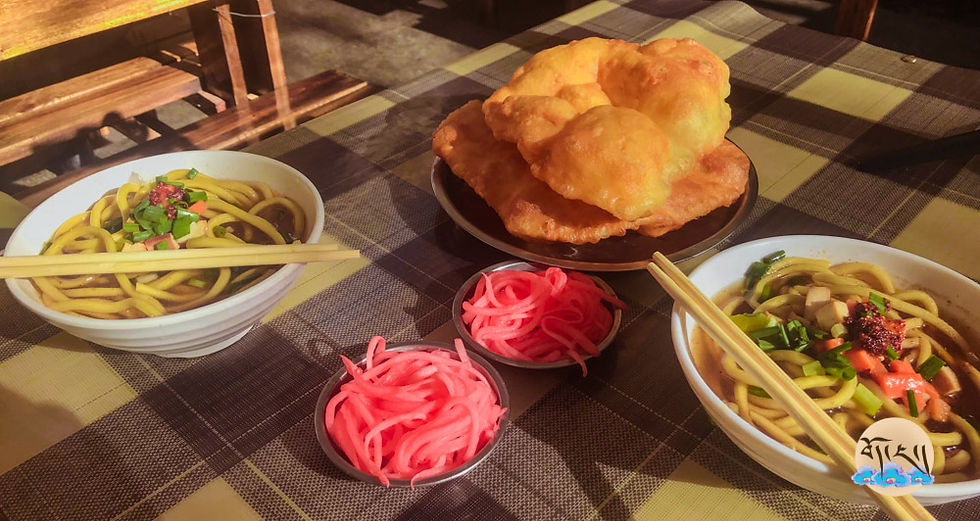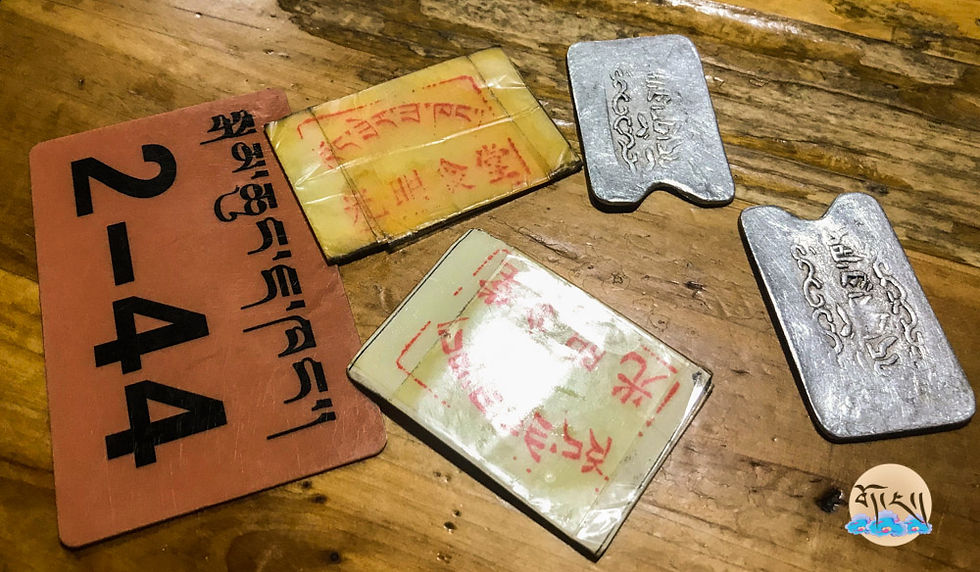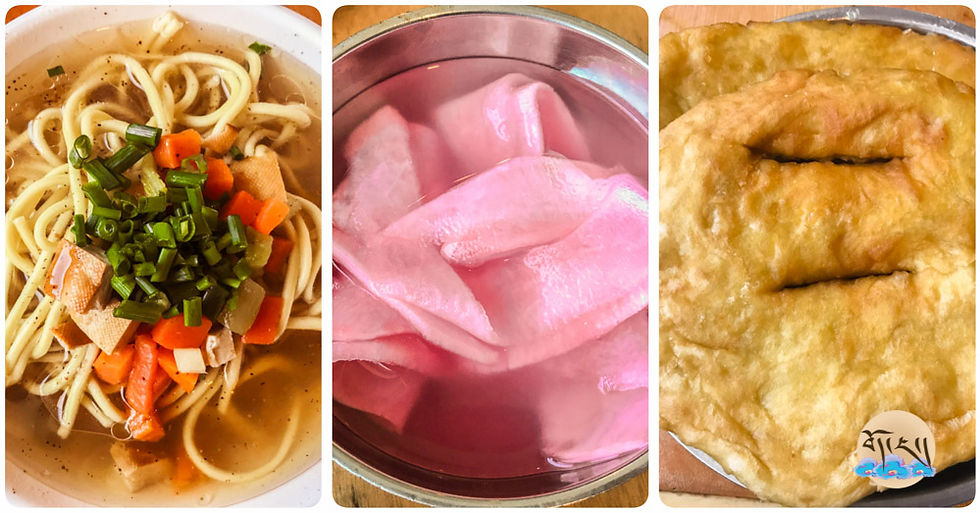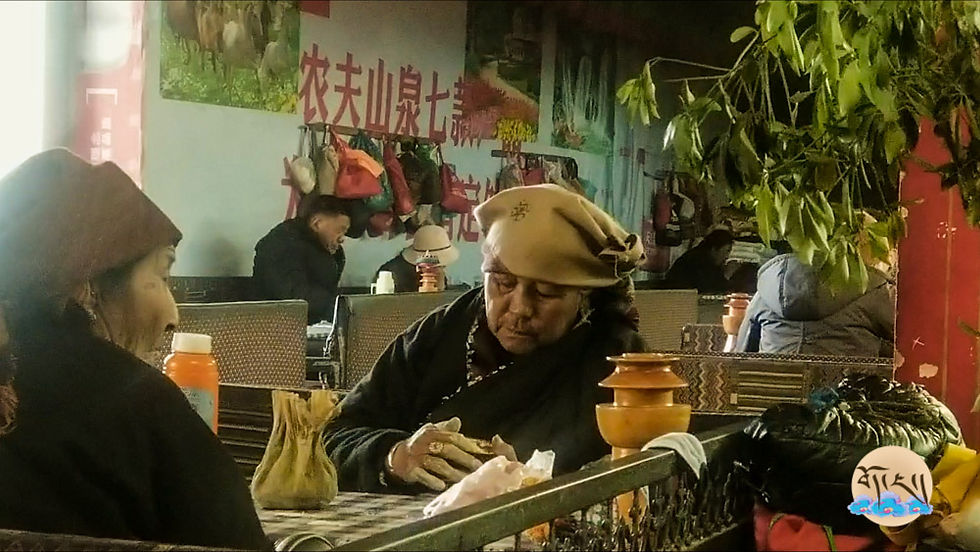Tibetan teahouses (part 2: Having tea and snacks)
- Salt Butter Tea

- Mar 13, 2019
- 5 min read

Last time, we discovered together what is “teahouse culture” in Tibet. It is a central place in Tibetan life, where you get all the information you need about pretty much everything (news from the TV, philosophical debate, people’s health, news about your friends and family, pilgrimage, etc).
Knowing this, this time, we need to get real. How to order food in a Tibetan teahouse (quite differently from Western teahouses or coffee shops) and what can we drink and eat there?
Tibetan teahouses
Part 2: "Having tea and snacks"
1) How to order tea and food in a teahouse?
This is how you order in a teahouse:
First, you go to the front desk to order your food and to pay. This is where Tibetans might fight to be the one to pay (we will talk about that another time).
Then, you will get a little card for each type of dish you are ordering (one card for your tea, one card for your noodles, one card for your fermented radish, fried potatoes etc.) You can see those cards in our trailer video below!

Then, you go get your food yourself. You have to show your card to the relevant staff member. If the teahouse is big, you will have different sections for the tea, the noodles, the fried bread, etc. If the teahouse is small, you will usually still have a section for the tea and a section for the food. The staff member will take your card and will give you your order in return. Most of the time, your order will be ready within minutes. Sometimes, you might need to wait at your seat, if the order takes longer. The waiter will either recognize you or will walk around screaming what is ready (for instance “two bowls of Tibetan noodles, two bowls of Tibetan noodles”). Waiters seem to never question a person who claims an order.
At the same time, you also have to get yourself the glasses for the tea. The glasses are usually in a transparent cupboard in a corner of the teahouse. The tea will be served in a thermos (you choose the size when ordering) and you will pour it yourself in your glass.
Finally, you go and sit somewhere. It’s usually best to choose a seat when entering the teahouse (your friend can wait for you there). However, some people will not look for a seat, knowing that people, even strangers, will be kind enough to make room for them, even if the teahouse is crowded.
The only exception to this ordering system is the tea. Sometimes, in some teahouses, a staff member will pass among people with a huge teapot and will pour you tea in exchange for 1 RMB.
2) Which drinks and food can you get in a teahouse?
Teahouses offer tea first of all. The most common drink is sweet tea. Then they usually offer some light food dishes, such as “Tibetan noodles”. You can also get some other snacks, but nothing like restaurant dishes.
Some examples of drinks served in teahouses:
Sweet tea, even though not initially from Tibet, is the most common drink in Tibetan teahouses. It is your standard black tea with milk and sugar. In Tibetan, it is called “Cha Ngarmo” (ཇ་མངར་མོ།);
Tibetan salt butter tea is as you might know, is called “Cha Söma” (ཇ་བསྲུབས་མ།) or “Bö Cha” (བོད་ཇ།) is quite rare. It might be surprising as it is most traditional Tibetan drink. People are actually afraid the quality of the butter might not be good. People usually drink salt butter tea at their home instead (during the day or for breakfast mixed with barley flour), at their friends or relatives’ places. Or most often during weddings and funerals people drink quite a lot of salt butter tea. Essentially this type of tea is usually a more homey, cozy or familiar drink to be shared with friends and family at home, or at ceremonies (weddings, funerals, etc).
Tibetan black salted tea is another type of tea. It is a light black tea, to which is added a little bit of salt. It is called “Cha thang” in Tibetan (ཇ་ཐང་།) It is certainly healthier than sweet tea, as it is not sweetened.
Milk mixed with tea is not often served in Lhasa teahouses. Lhasa people seem to prefer sweet tea. Preferences of course differ depending on the regions of Tibet. If you want to order one, you should ask for “O Cha” (འོ་ཇ།)
Milk is also served in some teahouses. You need to ask for “O Ma” (འོ་མ།)
You can also have the following snacks in teahouses:
The most common dish is “Tibetan noodles”. It is a warm dish composed of long homemade noodles with soup. In the meat version, you’ll have little squares of meat, green onions, and sometimes a few vegetables. In the vegetarian version (not always available), you’ll have green onions, maybe vegetables like carrots or cabbage, and perhaps tofu if you are in a good teahouse. Most Tibetans add chili to it, as they prefer spicy dishes. If you want to order one, ask for a “Phul Thuk" (བུལ་ཐུག or བོད་ཐུག). You can also order a version without soup.
Tibetans usually eat this noodle dish with fermented radish, mostly the pink coloured variety. It’s refreshing and cool, which counter-balances the warmth and spiciness of the Tibetan noodles. In Tibetan, fermented radish is called "Sön Labhuk" (སོན་ལ་ཕུག)
Some Tibetans like having their noodles with a sort of deep-fried round bread with two holes in the middle. Nowadays, a Chinese word is used to name them: “Yushang”, to which you can add “Bhalep” (བག་ལེབ།), which means bread.
You might also see fried potato chips, or hard boiled eggs.

The most interesting thing is that some people will bring their own things into the teahouse. First, some people might bring their own cup or bowl, usually a beautiful traditional wooden Tibetan bowl. Some will bring their own butter, order a black salted tea and add the butter to the black salted tea. Others will bring their own “Tsampa”, the traditional barley flour, to mix it with tea. We will talk to you about “Tsampa” another time for sure, since it is probably the most important food for Tibetans. Sometimes, you can even see people who bring their own tea… in the teahouse.

Even better, since they come very often, some people leave their stuff in the teahouse. Usually, they leave their bowl and their “Tsampa”. Teahouse owners put nails on the wall and people hang a little bag containing their bowl and their “Tsampa”.

There is so much more to tell you, but we do not want to overflow you with too much information. If you have any questions, ask us and we will answer to the best of our abilities.
Special thanks to Thomas Pan who proofread this article!








Comments